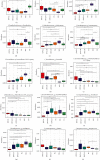Jiedu-Yizhi Formula Alleviates Neuroinflammation in AD Rats by Modulating the Gut Microbiota
- PMID: 35958910
- PMCID: PMC9357688
- DOI: 10.1155/2022/4023006
Jiedu-Yizhi Formula Alleviates Neuroinflammation in AD Rats by Modulating the Gut Microbiota
Abstract
Background: The Jiedu-Yizhi formula (JDYZF) is a Chinese herbal prescription used to treat Alzheimer's disease (AD). It was previously confirmed that JDYZF can inhibit the expression of pyroptosis-related proteins in the hippocampus of AD rats and inhibit gut inflammation in AD rats. Therefore, it is hypothesized that JDYZF has a regulatory effect on the gut microbiota.
Methods: In this study, an AD rat model was prepared by bilateral hippocampal injection of Aβ 25-35 and AD rats received high, medium, and low doses of JDYZF orally for 8 weeks. The body weights of the AD rats were observed to assess the effect of JDYZF. The 16S rRNA sequencing technique was used to study the regulation of the gut microbiota by JDYZF in AD rats. Immunohistochemical staining was used to observe the expression levels of Caspase-1 and Caspase-11 in the hippocampus.
Results: JDYZF reduced body weight in AD rats, and this effect may be related to JDYZF regulating body-weight-related gut microbes. The 16S rRNA analysis showed that JDYZF increased the diversity of the gut microbiota in AD rats. At the phylum level, JDYZF increased the abundances of Bacteroidota and Actinobacteriota and decreased the abundances of Firmicutes, Campilobacterota, and Desulfobacterota. At the genus level, the abundances of Lactobacillus, Prevotella, Bacteroides, Christensenellaceae_R-7_group, Rikenellaceae_RC9_gut_group, and Blautia were increased and the abundances of Lachnospiraceae-NK4A136-group, Anaerobiospirillum, Turicibacter, Oscillibacter, Desulfovibrio, Helicobacter, and Intestinimonas were decreased. At the species level, the abundances of Lactobacillus johnsonii, Lactobacillus reuteri, and Lactobacillus faecis were increased and the abundances of Helicobacter rodentium and Ruminococcus_sp_N15.MGS-57 were decreased. Immunohistochemistry showed that JDYZF reduced the levels of Caspase-1- and Caspase-11-positive staining.
Conclusion: JDYZF has a regulatory effect on the gut microbiota of AD rats, which may represent the basis for the anti-inflammatory effect of JDYZF.
Copyright © 2022 Jiale Wang et al.
Conflict of interest statement
The authors declare no conflicts of interest.
Figures







Similar articles
-
Jiedu Yizhi Formula Improves Cognitive Function by Regulating the Gut Dysbiosis and TLR4/NF-κB Signaling Pathway.Neuropsychiatr Dis Treat. 2023 Jan 4;19:49-62. doi: 10.2147/NDT.S393773. eCollection 2023. Neuropsychiatr Dis Treat. 2023. PMID: 36627886 Free PMC article.
-
Jiedu-Yizhi Formula Improves Cognitive Impairment in an Aβ 25-35-Induced Rat Model of Alzheimer's Disease by Inhibiting Pyroptosis.Evid Based Complement Alternat Med. 2022 Mar 16;2022:6091671. doi: 10.1155/2022/6091671. eCollection 2022. Evid Based Complement Alternat Med. 2022. PMID: 35341145 Free PMC article.
-
Effects of Qishen Dihuang Granules on Intestinal Microbiota in Experimental Autoimmune Myasthenia Gravis Model Rats.Altern Ther Health Med. 2023 Jul;29(5):342-352. Altern Ther Health Med. 2023. PMID: 37171946
-
Banxia-Yiyiren alleviates insomnia and anxiety by regulating the gut microbiota and metabolites of PCPA-induced insomnia model rats.Front Microbiol. 2024 Nov 7;15:1405566. doi: 10.3389/fmicb.2024.1405566. eCollection 2024. Front Microbiol. 2024. PMID: 39575182 Free PMC article.
-
Rhizoma Gastrodiae Water Extract Modulates the Gut Microbiota and Pathological Changes of P-TauThr231 to Protect Against Cognitive Impairment in Mice.Front Pharmacol. 2022 Jul 15;13:903659. doi: 10.3389/fphar.2022.903659. eCollection 2022. Front Pharmacol. 2022. PMID: 35910384 Free PMC article.
Cited by
-
Bibliometric analysis of research on Alzheimer's disease and non-coding RNAs: Opportunities and challenges.Front Aging Neurosci. 2022 Oct 18;14:1037068. doi: 10.3389/fnagi.2022.1037068. eCollection 2022. Front Aging Neurosci. 2022. PMID: 36329875 Free PMC article.
-
The effects of Qingchang Ligan formula on hepatic encephalopathy in mouse model: results from gut microbiome-metabolomics analysis.Front Cell Infect Microbiol. 2024 Aug 16;14:1381209. doi: 10.3389/fcimb.2024.1381209. eCollection 2024. Front Cell Infect Microbiol. 2024. PMID: 39220284 Free PMC article.
-
Herbal medicine and gut microbiota: exploring untapped therapeutic potential in neurodegenerative disease management.Arch Pharm Res. 2024 Feb;47(2):146-164. doi: 10.1007/s12272-023-01484-9. Epub 2024 Jan 15. Arch Pharm Res. 2024. PMID: 38225532 Free PMC article. Review.
-
Relationship between sheep feces scores and gastrointestinal microorganisms and their effects on growth traits and blood indicators.Front Microbiol. 2024 Feb 14;15:1348873. doi: 10.3389/fmicb.2024.1348873. eCollection 2024. Front Microbiol. 2024. PMID: 38419634 Free PMC article.
-
Ginseng and Polygonum multiflorum formula protects brain function in Alzheimer's disease.Front Pharmacol. 2025 Feb 20;16:1461177. doi: 10.3389/fphar.2025.1461177. eCollection 2025. Front Pharmacol. 2025. PMID: 40051562 Free PMC article.
References
-
- Alzheimer’s Association Report. 2021 Alzheimer’s disease facts and figures. Alzheimers Dement . 2021;17(3):327–406. - PubMed
LinkOut - more resources
Full Text Sources

